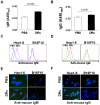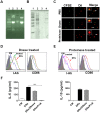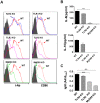Tumor-derived autophagosomes (DRibbles) induce B cell activation in a TLR2-MyD88 dependent manner
- PMID: 23326458
- PMCID: PMC3541185
- DOI: 10.1371/journal.pone.0053564
Tumor-derived autophagosomes (DRibbles) induce B cell activation in a TLR2-MyD88 dependent manner
Abstract
Previously, we have documented that isolated autophagosomes from tumor cells could efficiently cross-prime tumor-reactive naïve T cells and mediate tumor regression in preclinical mouse models. However, the effect of tumor-derived autophagosomes, here we refer as to DRibbles, on B cells has not been studied so far. At present study, we found that DRibbles generated from a murine hepatoma cell line Hep1-6, induced B-cell activation after intravenous injection into mice. B-cell populations were significantly expanded and the production of Hep1-6 tumor-specific antibodies was successfully induced. Moreover, in vitro studies showed that DRibbles could induce more efficient B-cell proliferation and activation, antibody production, and cytokine secretion than whole tumor cell lysates. Notably, we found that B-cell activation required proteins but not DNA in the DRibbles. We further showed that B cells could capture DRibbles and present antigens in the DRibbles to directly induce T cell activation. Furthermore, we found that B-cell activation, antibody production, cytokine secretion and antigen cross-presentation were TLR2-MyD88 pathway dependent. Taken together, the present studies demonstrated that tumor-derived autophagosomes (DRibbles) efficiently induced B cells activation, antibody production, cytokine secretion and antigen cross-presentation mainly depending on their protein component via TLR2/MyD88 dependent manner.
Conflict of interest statement
Figures







Similar articles
-
Tumor-Derived Autophagosomes (DRibbles) Activate Human B Cells to Induce Efficient Antigen-Specific Human Memory T-Cell Responses.Front Immunol. 2021 May 26;12:675822. doi: 10.3389/fimmu.2021.675822. eCollection 2021. Front Immunol. 2021. PMID: 34122437 Free PMC article.
-
Therapeutic antitumor efficacy of B cells loaded with tumor-derived autophagasomes vaccine (DRibbles).J Immunother. 2014 Oct;37(8):383-93. doi: 10.1097/CJI.0000000000000051. J Immunother. 2014. PMID: 25198526 Free PMC article.
-
Macrophages enhance tumor-derived autophagosomes (DRibbles)-induced B cells activation by TLR4/MyD88 and CD40/CD40L.Exp Cell Res. 2015 Feb 15;331(2):320-30. doi: 10.1016/j.yexcr.2014.10.015. Epub 2014 Oct 24. Exp Cell Res. 2015. PMID: 25447440
-
The Role of TLR4 on B Cell Activation and Anti-β2GPI Antibody Production in the Antiphospholipid Syndrome.J Immunol Res. 2016;2016:1719720. doi: 10.1155/2016/1719720. Epub 2016 Oct 27. J Immunol Res. 2016. PMID: 27868072 Free PMC article. Review.
-
Identification of B cell antigens in solid cancer: initial insights and functional implications.Front Immunol. 2025 Apr 28;16:1571570. doi: 10.3389/fimmu.2025.1571570. eCollection 2025. Front Immunol. 2025. PMID: 40356924 Free PMC article. Review.
Cited by
-
Emerging Autophagy Functions Shape the Tumor Microenvironment and Play a Role in Cancer Progression - Implications for Cancer Therapy.Front Oncol. 2020 Nov 25;10:606436. doi: 10.3389/fonc.2020.606436. eCollection 2020. Front Oncol. 2020. PMID: 33324568 Free PMC article. Review.
-
Regulatory B cells in cancer.Immunol Rev. 2021 Jan;299(1):74-92. doi: 10.1111/imr.12939. Epub 2020 Dec 23. Immunol Rev. 2021. PMID: 33368346 Free PMC article. Review.
-
Tumor-Derived Autophagosomes (DRibbles) Activate Human B Cells to Induce Efficient Antigen-Specific Human Memory T-Cell Responses.Front Immunol. 2021 May 26;12:675822. doi: 10.3389/fimmu.2021.675822. eCollection 2021. Front Immunol. 2021. PMID: 34122437 Free PMC article.
-
Tumor cell-released autophagosomes (TRAP) enhance apoptosis and immunosuppressive functions of neutrophils.Oncoimmunology. 2018 Mar 6;7(6):e1438108. doi: 10.1080/2162402X.2018.1438108. eCollection 2018. Oncoimmunology. 2018. PMID: 29872581 Free PMC article.
-
Therapeutic antitumor efficacy of B cells loaded with tumor-derived autophagasomes vaccine (DRibbles).J Immunother. 2014 Oct;37(8):383-93. doi: 10.1097/CJI.0000000000000051. J Immunother. 2014. PMID: 25198526 Free PMC article.
References
Publication types
MeSH terms
Substances
LinkOut - more resources
Full Text Sources
Other Literature Sources

